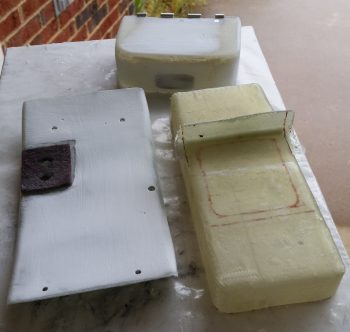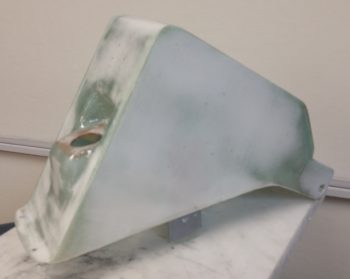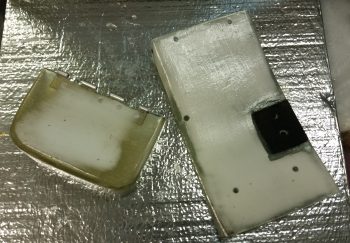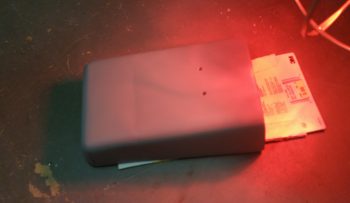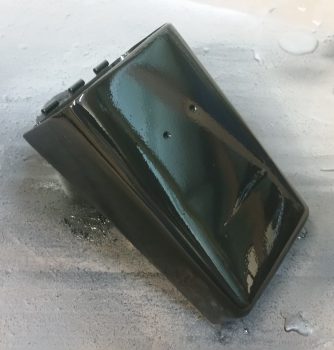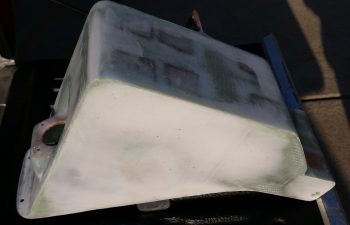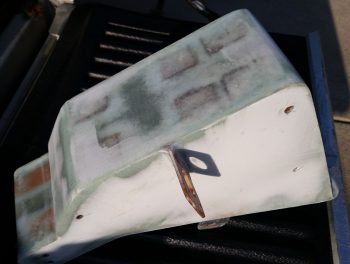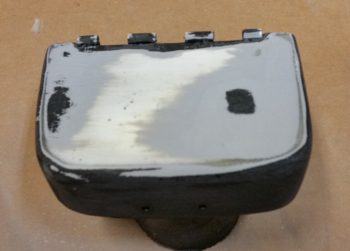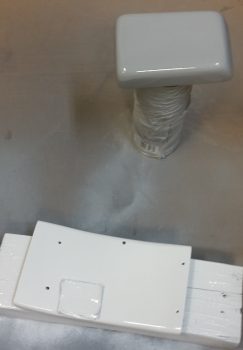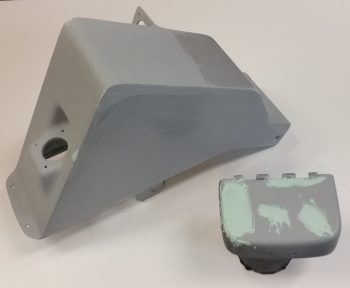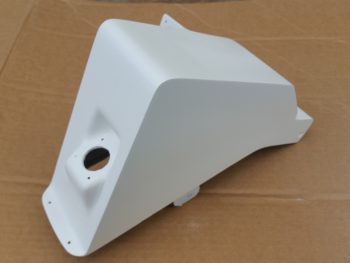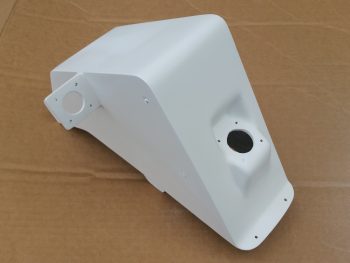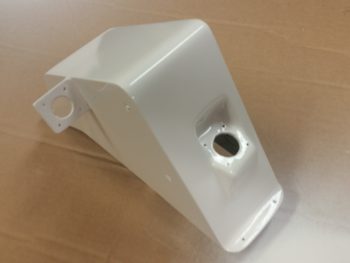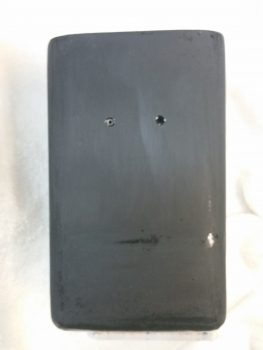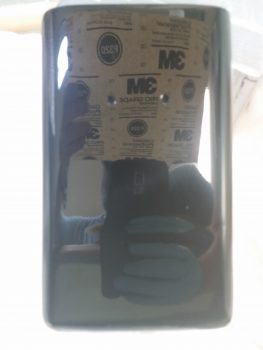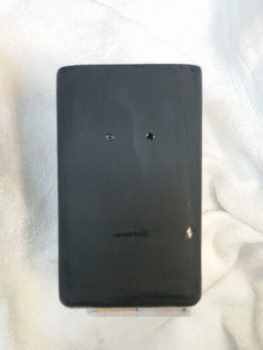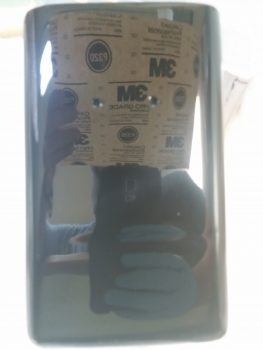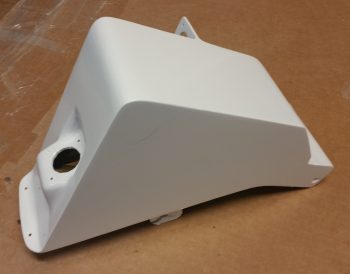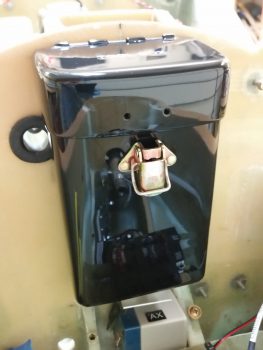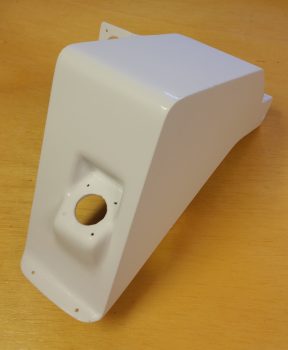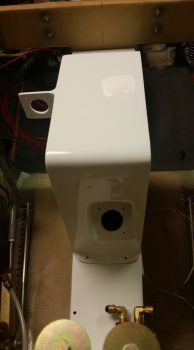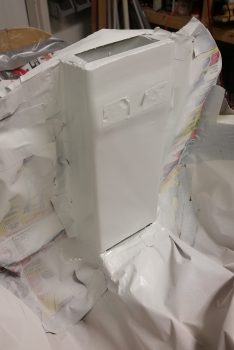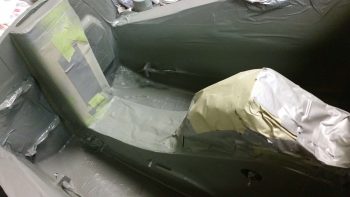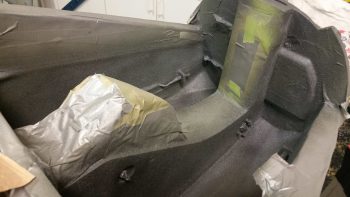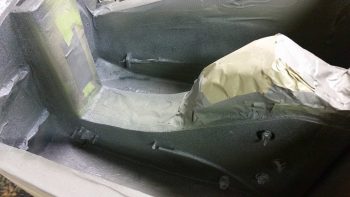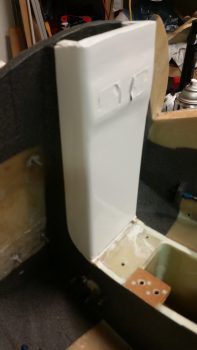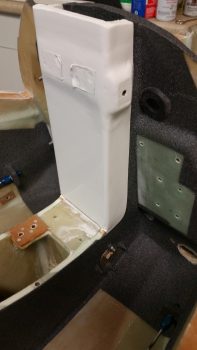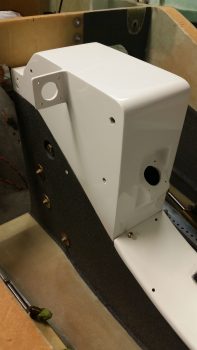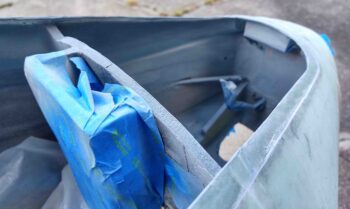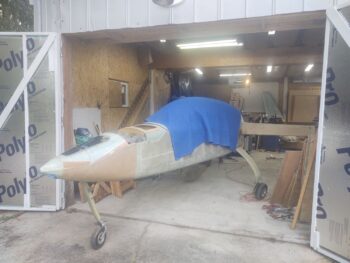Chapter 25 – Finishing Nose Compartment, NG30 Covers & Tool Box
15 April 2017 — The remaining micro that I didn’t use for filling the gaps on the aft NG30 cover (see Chap 13 – Nose), I used to cover the forward NG30 cover for finishing. I taped up the felt mounting pad for the Matco parking brake, then slathered on the micro.
Quite a number of hours later I spent a good 20 minutes sanding down the micro on the forward NG30 cover. The micro was still in its sweet spot “green” stage allowing me to cheese grate it, meaning it sanded way easier than if fully cured and comes off in clumps versus micro dust.
Also, here’s a shot of the tool box lid that I micro’d up with some leftover MGS epoxy that I had earlier in the day. I also cheese grated the lid as well, although I didn’t get an after shot of it . . . yet.
•••
17 April 2017 — Today I assembled some of the nose pieces that I would be working on (clockwise from the top): tool box lid, battery tray, and forward NG30 cover. This pic was taken after I sanded the tool box lid and forward NG30 cover with 32 grit sandpaper. In addition, I had done an initial rough trim on the battery box flange, and right after this pic was taken I trimmed the sides of the battery box flange….
And yet another shot of all the parts I would be working with: the front & aft NG30 covers, and the tool box lid & body. The front NG30 cover and tool box lid will get 3 epoxy wipes, with 2 hours in between the coats. The aft NG30 cover and the tool box body will both get slathered up with micro for finishing.
This is epoxy wipe #2 (I think . . .) on the forward NG30 cover and the tool box lid.
And here is the aft NG30 cover and the tool box both slathered up with micro. I did the tool box first, and you can see that the micro I applied to it was a bit wetter than it should have been, although it still sanded out fine (as you can see below).
Below represents a good hour’s worth of solid sanding between the NG30 cover and the tool box body.
•••
18 April 2017 — Today was a long build day overall, but not an overly productive one. The reason being that today was essentially epoxy wipe day for the tool box . . .
And the aft NG30 cover.
After prepping the parts late this morning, I applied the first epoxy wipe (using West) and then waited 2 – 2.5 hours and then added the next coat, waited and then repeated. I applied a total of 4 coats of epoxy before letting them alone to cure overnight.
With the aft NG30 cover and tool box body epoxy wipes curing, I checked them one last time and then called it a night.
•••
19 April 2017 — Today I started by taking another shot of the tool box lid and forward NG30 cover for posterity’s sake, just before I sanded them for primer coating.
I then sanded the tool box lid to prep it for primer.
And then did the same for the forward NG30 cover.
Here’s the tool box lid and forward NG30 cover in GRAY (although it almost looks white) primer.
I didn’t get a pic for posterity’s sake for the lower tool box body, so here it as after I primered it.
Again, although this looks white, the lower tool box body really is in gray primer here after a quick sand down and re-wash (I use Simple Green to wash my parts, a trick I learned when painting motorcycles). This pic shows it right before I shot it with black paint
I then shot the tool box body black with 2 coats.
This is a couple of hours later than the pic above. You can see the paint leveled out quite a bit as it cured, and it really does look good. It’s not perfect, and if it were an external part or in constant view I would probably wet sand it and shoot it one more time, or clear coat it. But this tool box is going into the nose, with the body mostly covered by the battery and the lid, so I’m going to call this good and press on.
For the NG30 covers, being much larger center pieces when the nose is opened up, I decided to clear coat them from the get go. Still, nothing too fancy. I grabbed some flat white Rustoleum primer and am using that for the base coat. After the base coat cures, I’ll wet sand it and then I’ll hit it with a few rounds of clear. Depending on how that turns out, I may do one final wet sanding and another coat or two of clear (sorry the pic quality, it seems my phone has been having issues focusing lately. I think I’m going to have to switch back to the camera ….)
I had to do a fair amount of sanding after the first round of primer on the tool box lid, so I went ahead and re-primered it with another couple of coats. After I good amount of time I picked it up in ham-fisted fashion to see how it looked, and disturbed the primer on the top side. So, I hit it again with a good wet coat of primer on the top and let it cure some more. After a bit of time went by, I threw it under a heat lamp for a couple of hours to get it nice and cured. I then re-sanded it, gave it a Simple Green bath and then hit it with 3 coats of black. FYI, this black is primer + gloss black paint mix.
•••
21 April 2017 — Although I didn’t get a lot done today I think it was fairly significant. I started off by sanding the entire aft NG30 cover down in preparation for priming. That was nearly an hour effort in and of itself. It’s interesting how “straight” these components can look to the naked eye, but once you apply micro and sand it down, then even the subsequent sanding after a few coats of epoxy, you see how off it was from the beginning. No worries of course because that’s exactly what the finishing process is all about.
After I sanded it, I washed it down with Simple Green and set it outside on my truck tailgate in the sun to dry thoroughly.
I then took the aft NG30 cover around to my side yard and hit it with 3 coats of primer.
Here’s a couple more shots after I brought it back into the garage.
I then wet sanded the tool box lid with some 500 grit sandpaper. It looked like all the imperfections were gone, so I cleaned it up, and printed out a label for it (which I mistakenly roughed up just barely with the 500 grit sandpaper).
Labels are notoriously difficult to clear coat, so I misted it a couple of times before hitting it with a full application of clear coat.
However, I think unlike the regular Rustoleum paint with its “few minutes” between coats, the clear coat has a quicker flash time in between coats (my current guess, but I’ll have to research more) because what started out as minor workable orange peeling turned into cracks that would put those in the Gobi Desert to shame! In short, adding the label and clear coat Round 1 was a GIANT FAIL!
Ok, lessons learned and back to the drawing board . . .
•••
22 April 2017 — I have to admit when I first pulled these pics up on my phone I was wondering what the heck I had taken a picture of…
But, alas, since I sanded down through the actual epoxy wipes into the micro layer on each side of the cover in its never-ending contouring cycle, I created (or uncovered) some pin holes… which of course is the main things the epoxy wipes eliminate.
So, before doing some electrical diagram administrivia this morning, I did some quick epoxy wipes in a few targeted areas on the aft NG30 cover.
•••
24 April 2017 — I started off today by sanding down the top of the tool box lid with a straight sanding board with 80 grit on it. I took it down until it was level and then hit the top & sides a bit more lightly with 180 grit. I then washed it up & prepped it for a reapplication of high build primer.
I tossed around the idea of just going back in with paint, but it’s going to need a couple of rounds of TLC for the surface to be ready for paint. That being said, I just hit it with one medium coat and called it good.
I then spent over 1.5 hours on prepping the aft NG30 cover for final primer. The top left forward corner and lower left edge where it meets the NG30 plate were both a bit shallow, so I added in some glazing putty to fill it in. I use the same stuff I did when I was building my custom motorcycle: Evercoat’s Metal Glaze. It works like a dream… mixes fast and creamy, and fills very smoothly. It also sands great as well.
I filled one depression on the right side of the cover, and the upper forward corner area on the right as well.
After sanding down the filler and blending it in, I then hit the aft NG30 coat with 2 more coats of primer.
If you look closely, you can see the bleed through of the filler to the surface. I’ll lightly sand the cover one more time, then most likely hit just these areas again with primer before final paint. It may seem like I’m being overly fussy, but just like in composites, the prep in painting is really what takes the longest. The final few coats of base coat (or final here) is the culmination of a lot of prep. I just want to get this finish dialed into an acceptable level (yes, it doesn’t help that I’ve done body work & painting before… in that I’m sure it makes me a bit more picky) so every time I look at it I don’t get a gnawing feeling that I left a half hour more work on the table to clear up a minor, yet glaring, imperfection.
I was going to use a white primer on both the NG30 covers, then simply clear coat them. However, the primer I picked up was just not bright enough white for me to go on as the final color. So while I was out I picked up some actual paint (vs primer) and will just go with that, like I did on the tool box.
I then sanded down the boat paint trial application off the GPS antenna cover that will crown my headrest, and also prepped the forward NG30 cover. I hit the GPS antenna cover with a couple rounds of primer while I final coated the forward NG30 cover with 2 coats of gloss white. I’m using gloss on a few of the internal nose components (the GPS antenna cover will not get gloss) just to make them pop a bit and stand out from the otherwise mass of matt finish that will be the main finish in the nose compartment and cockpit.
I was doing some research online about Rustoleum paint, and ran across something that made sense to me: since rattle can paint & primer doesn’t incorporate a reducer (like auto paint), it takes a few days to really off-gas and cure to a good point. I noticed this dynamic on the lower tool box, thus I figured I would leave this stuff alone for at least 24-30 hours before working on it again.
[NOTE: For the time being, with a lack of a better place to put it, I’m including the GNS480 GPS antenna cover here…]
•••
25 April 2017 — Today I touched up the aft NG30 cover with just a couple dabs of metal glaze and gave it another good epoxy wiping to eliminate some more pin holes that popped up. As you can see, I also slathered up the tool box lid to hopefully remove the minor surface irregularities that have been plaguing me in trying to get this one small part painted!
In addition, although taken quite a number of hours after I applied 3 coats of off-white primer, here’s a shot of the GNS480 GPS antenna cover that will sit atop my headrest. Since I had to go to town on it to remove the thick layers of my boat paint trial application, it too will need some TLC to smooth out the finish on it as well. Regardless, the color you see below will pretty much be the final color for this piece.
•••
26 April 2017 — Today I did the final sanding on the aft NG30 cover after the final application (hopefully) of Metal Glaze and epoxy wipes to clear up some minor blemishes & pin holes. I sanded down the cover, focused on dialing in the final surface prep for paint. Of course some of underlying filler broke through, but no worries since I hit it with a light colored primer.
I then applied 3 coats of white primer to lock in my surface prep work. I’m sure there’s a good chance that I’ll have to do some more minor fills, and possibly even another coat of white primer, but as you can see it’s definitely looking more & more polished!
•••
29 April 2017 — Today I spent a decent amount of time sanding down the perpetual painting project from hell: the nose tool box lid. This thing has given me an amazing amount of grief in trying to simply get it painted black… to the point of being comical.
Before I actually started sanding & priming the 2 items above I found about 6 pinholes that had crept back up on the surface of the aft NG30 cover, so I filled those with tiny dabs of Metal Glaze. I then went on to sand and prime the lid and cover above.
Well, lo and behold there were a few more pinholes that I hadn’t noticed in the shop light, until I took the aft NG30 cover outside. I then whipped up a tiny bit more Metal Glaze and repeated the process (it’s very workable in 20 min, versus the long cure time for epoxy).
Finally, after messing around with the items above for a good bit of time, I was able to do a final EZ sand down of the aft NG30 cover, give it a good bath in Simple Green, and hit it with 3 coats of gloss white paint.
•••
2 May 2017 — Today I lightly sanded the problem child from hell (AKA “the tool box lid”) and hit it with 3 coats of gloss black paint. True to form, it was a slightly breezy day outside and the paint had lots of nice little added surface bits by the time I was done. I had already decided to actually wet sand these and finish them with clear coat and then buff them out. That’s the major reason I haven’t riveted the latch on the lower tool box. I wasn’t really planning on going in that direction, but for some inexplicable reason this particular paint has been such a challenge that I don’t see any other way right now… that is if I want decent looking paint on the tool box. And I do.
•••
7 May 2017 — Today I wet sanded the tool box with 500 grit wet/dry sandpaper, let it dry, then mounted it, and hit it with 2 good coats of clear coat.
While the lower tool box body clear coat was drying, I then wet sanded the tool box lid, which of course proved to be a bit more stubborn than the tool box body in smoothing out the surface imperfections. I got to a point where I just needed a bit of clean up around the corners when of course –although being VERY careful– I broke through the black paint to the primer below. This tool box lid truly is proving to be the problem child from hell! So, I dried it off and hit the corner edges with 2 more coats of black paint. I’ll let it dry a few days before wet sanding it again and hopefully getting a few good coats of clear on it!
•••
9 May 2017 — Yes, the PROBLEM CHILD FROM HELL is gone!!! Yeah!
Of course I’m talking about the Tool Box Lid. Ah, yes, I will regale you with that story in a bit, but first . . .
Today I started by wet sanding the tool box body with 500 grit, then 1000 grit, and finished with 1200 grit. I could have gone to a higher grit, but I wanted to see if the 1200 wet-sanded surface would buff out nicely.
Well, I have to say I think it did! Now, I could have used a dual action electric buffer but I really didn’t want to end up cutting through the paint (Rust-Oleum is a bit soft as paints go) so I used the old fashioned elbow grease method on this puppy (or, maybe that’s shoulder grease method because that’s what hurts the most!!) It took me about an hour total as I worked each section (side, front, corners) with good overlap in-between. I used a basic wax applicator pad to apply the cutting compound, and a microfiber cloth to remove it.
After I got it all buffed out, I then switched to a new applicator and cloth to finish out the process with a couple of applications of Meguiar’s Ultimate Polish. I have to say, for what was essentially an experiment this was certainly a success in my book!
Here’s another shot of me doing the ‘ol “can I read the print in the finish?” trick. Obviously you can, and I am of course very happy with how this buffed out. I will say that it’s actually difficult in the pics to get the black color to show up. In person you can really see the black color first, and then the nice shiny reflection in the color.
I then mounted the tool box and grabbed another shot of it, hoping to get more of the black color to show up. I think it did just a bit more here vs. the pics above.
I then repeated the buffing process for the forward NG30 cover, except since I didn’t clear coat this piece I very lightly wet sanded it with 500 grit before almost immediately jumping to 1000 grit. I then finished up again with 1200 grit.
Between the white color and this piece not having been clear coated, you can see that the final shine is not nearly as stunning on the forward NG30 cover as it is on the tool box. No worries at all since this piece still came out very nice, and since it will be down at the bottom of the nose well it really won’t be a centerpiece item or noticed as much.
Also, this finish on the forward NG30 cover does tell me though that I will be wet sanding and clear coating the aft NG30 cover before it gets installed back in place. Here’s another shot of the forward NG30 cover after I buffed it out.
And one of the forward NG30 cover set in place where it will get installed.
Ok . . . then came the crowning moment of the entire last couple of weeks!!! I finally was able to get a good wet sanding accomplished on the nose tool box lid! I then carefully cut and placed the label on the top after measuring it out to ensure it was centered. I then quickly wiped down the entire lid with some Acetone to ensure I didn’t get a repeat of the mysterious contamination I had last time.
I then grabbed the can of Gloss Clear Coat, shook the living crap out of it, and started with a very light mist coat over the top of the tool box lid to give the clear something to grip to on the slick label surface. I waited a little over a minute than hit it with just another, very slightly thicker mist coat. I then waited about 2 minutes before hitting it with its first real coat of clear. After that, I gave it 3 more good coats for a total of 4 coats of clear, with about 4 minute intervals in between. Normally I would go with 2 coats of clear, but with the label on top I wanted a little bit higher build for wet-sanding before buffing it out.
I thought I’d leave you with a final before & after shot of the tool box body. I really am very pleased with how well it turned out.
•••
10 May 2017 — I started off today sanding down the aft NG30 cover with some 220 grit sandpaper (sorry for the blurry pic). I then needed to add a tiny bit of Metal Glaze to a few spots for some minor blemish cleanup.
As the Metal Glaze was curing I then grabbed the tool box body and redrilled the 2 rivet holes on the front face that will be used to mount the lower latch assembly.
Speaking of which, here is the lower latch assembly right here. I quickly realized that my rivet hand squeezer didn’t have a deep enough arm to allow me to set these rivets. Guess I’ll have to track down some RV buddies in my local EAA chapter!
Shortly after setting the lower tool box latch in place, I took the dried GPS antenna cover and the aft NG30 cover outside and hit them with high build primer and 3 final coats of paint, respectively. On the NG30 cover, I was only retouching the left side and front, so I added 3 more coats of paint since I’ll be giving it a good wet sanding before clear coating it.
Here’s a pic of the aft NG30 cover with it’s 3 latest coats of paint on the left & front sides. I did manage to get one run in the upper left corner on the side, but it should be no big deal since I’m going to give this a good wet sanding, then 2-3 coats of clear coat.
Here’s the front side of the aft NG30 cover. Again, I’m going to wet sand the entire thing before hitting it with clear coat.
•••
11 May 2017 — Today I turned my sights back onto getting some of these painted parts knocked out. I wet sanded the tool box lid lightly with 500 grit sandpaper, then 1000 grit and finally 1200 grit.
As I buffed out the tool box lid I was also uploading the lengthy video above. It took a little over an hour total to buff out the tool box lid by hand.
Again, after the Ultimate cutting compound application, I then wrapped up the tool box lid by hitting it with 3 rounds of Meguiar’s Ultimate Polish.
I then set it on top of the tool box body.
•••
14 May 2017 — Tonight, my last official build act for the evening was wet sanding the aft NG30 cover. I set aside clear coating the NG30 cover until later since there’s a couple of areas on the cover that I want to assess.
•••
17 May 2017 — Today I did in fact get something done… albeit not very well! I clear coated the aft NG30 cover with 3 coats of clear coat, but apparently there was some contamination on the surface because I had some issues.
As you can see on the front, I had a bit of an adhesion problem.
And, to add insult to injury, a nice run on each side. Ugh. So, I’ll try to just wet sand it and see if I can buff it out after I wet sand, or I may have to re-clear it. More to come on this.
•••
9 May 2018 — Today I finished prepping the NG30 for its final finish. I will state up front that with standard rattle can (Rustoleum) primer, paint and clear coat, it’s a bit tricky to maintain a sharp edge like the ones I have here. I do have some minor break throughs in the paint along the top right edge (looking at the pics below, actually on the left side) and one spot a hair under a centimeter on the lower edge also on the right side.
So, I’m invoking 2 sayings. The first is: “Perfect is the enemy of good enough” (I think Gen Petraeus said that) and the opposing viewpoint: “One ‘ah-shit!’ can ruin a thousand attaboys!” ….. so, my NG30 covers all ends of the spectrum! In short, since this is round 2 on paint and clear coating, it will have to do. I can’t spend another countless number of days dialing this into perfection or using a different paint system that lends itself to maintaining structural integrity on a hard 90° edge (like epoxy primer on a 2-part system).
The end result for the evening was that I got the right side (again, per pics…although pic below is pre-buffout) and the top buffed out, but still needing polish.
With so many surface scratches I put on these things getting rid of my just silly number of runs, I would actually buff for a bit, then heretically wet sand with very fine paper on whatever scratches were still visible. Then back to buffing out. So far the results have been fairly good. I’ll state for the record that if this were a part in constant view I might rethink doing it to a bit higher standard (also for the record, it still looks pretty darn good!), but not when it spends over 90% under cover in the nose.
•••
12 May 2018 — Today I got back to work on the NG30 aft cover. I wanted to get this thing knocked off my to-do list and it’s been long overdue. I really screwed up the paint pretty good with all those runs on the surface, although I thought I took care of them. But as I was buffing it out with some rubbing compound I could see some blemishes that needed more TLC with some very fine wet sanding.
My point in listing my self-inflicted woes on this thing is to highlight that I spent well over 3 hours finishing it up. But it’s done! (Note the reflection in the front face of the NG30 cover).
And a view of the left side of the finished NG30 cover.
I noted a strong reflection on the left side, so I grabbed a _________________ (can you tell?!) and held it in place.
Here’s another reflection shot on the NG30 cover’s top that shows a distinct reflection of one of the shop lights.
•••
13 May 2018 — So a few days ago my buddy and fellow Long-EZ builder Dave Berenholtz asked me if I was building a show plane, to which I answered something along the line with, “of course not!” Well, after my escapades this evening I can understand why he might ask me that. ha! I do definitely have some design ideas for the interior of my aircraft…. not really the cabin area mind you, but more the nose area. Nothing major, but I am essentially making a white accent stripe down the middle of the NG30 to lighten things up in the somewhat confined and dark spaces of the nose.
Given that, my last piece of the white center stripe –which I’ll paint first before the tad bit of color (same as nose wheel cover) that I’ll be putting on the sidewalls and NG30 sides– is what I call the goal posts… actually the goal posts existed before I put the plate in on top of it. FYI – the “Goalpost mini bulkhead” is what the original plans called out as F6.
Anyway, this mini-NG30 bulkhead will get painted white, overlapping a bit on the sides. The fancy part is that I taped in a curve at the bottom side to somewhat match the curve on the front edge of the forward NG30 cover (For those of you in the US or know the Progressive “Box” Dude…. it kind of looks like that too me).
I will add that I prepped it with a thin skim coat of micro last night, and then after I sanded that down I hit with a thin skim coat of epoxy before heading to Harbor Frieght. To reduce the cure time so it would be ready to work on when I returned, I set a heat lamp on it.
Upon returning I lightly sanded the surface and prepped it for primer and paint.
Here’s the “goalpost” bulkhead after a couple of light coats of primer and then 2 standard coats of paint.
Tomorrow, after the top coat cures, I’ll sand it just enough to dull it and then hit it with a couple of coats of clear.
•••
14 May 2018 — My initial plan for the day was to wet sand and then clear coat the front NG30 mini-bulkhead so that I could have then wet sanded and buffed that out either later this evening or tomorrow, but alas I broke through the topcoat when I was wet sanding and had to repaint those areas with another couple coats of white paint.
Finally, much later in the evening I was able to successfully wet sand the white top coat and then clear coat it with a tack coat and then 2 full coats of clear. Yes, I understand that these pics probably look exactly the same as the gloss white top coats…. but trust me, THAT’S clear coat on there!
•••
15 May 2018 — Today I started by opening up the shop and got busy wet sanding the very front NG30 mini-bulkhead that I clear coated last night.
After wet sanding it I buffed it out with rubbing compound and then hit it with a couple coats of polish. It’s not perfect by any means but I think it will look great as a part of the white center NG30 “console”.
•••
23 May 2018 — After some much needed shop cleaning and organizing today, I finally used the deck chair pad that I purchased along with my pad of blue memory foam to experiment with different sitting heights. I think I’ve found what I like which would equate to about a 3″ bottom seat cushion that transitions into a 1-1/2″ to 2″ seat back cushion. This configuration really gives me a decent seat height for visibility and not feeling like I’m crammed into a low sitting 1950’s mini sports coupe.
I then spent a good 30 minutes dialing in my “final” rudder/brake pedal locations, which I wouldn’t be surprised if they end up moving by 1-2 mounting holes either fore or aft after the rudder cables and brakes are connected and operational.
I then removed the rudder/brake pedals and got to work on the laborious task of prepping the front nose area for paint. It was quite the pain, but I knew if I didn’t do it now that I wouldn’t have an opportunity to do it later so I knocked it out. Moreover, I wanted to get this nose paint shot and curing overnight.
After about 2 hours I had the nose area taped up and was ready to lay down some paint.
I started with a couple of light coats of gray self-etching primer.
And hit all the exposed spots in the nose area.
After letting the primer cure for about 45 minutes, I then hit it with a couple coats of the speckled top coat, which is the same trunk paint I used on the nose wheel cover (NB) and avionics bay area.
I let the top coat alone to cure for 30+ minutes and then removed the protective tape and paper.
If you were wondering what my white paint job was all about, here it is. As you can see it’s simply a designed accent feature to “cap” the forward end of what is essentially a big white stripe down the middle of the nose compartment. I figured the white NG30 covers and front mini-bulkhead would lighten up the nose compartment to offset the use of some dark speckled paint. Plus, I think the dark vs. light contrast just looks snazzy!
I left a good majority of the floor unpainted for a few reasons. First, I didn’t want to paint an area that I felt was a higher traffic area. Next, I did’t want too much dark paint in the nose compartment both from an aspect of visibility (being too dark) and minimizing paint weight where possible. Lastly, I like to keep a bit of what I consider the cool build features exposed, so analogous to the lower longerons that I left exposed, I could see the dished floor pan and embedded phenolic pedal hardpoint as some good/fun discussion points at fly-ins, etc.
I should also note that I will be adding in a small length of Nylaflow as a cable guide between the bottom of the pedal “S” curve on the front of the pedal assembly to a bolted in AN111-3 hardpoint that is located in the lower sidewall forward of the pedal assembly… on each side of course. The resulting layups to mount these small cable guides requires that the lower side wall remain clear, for now. I’ll most likely finish the sidewall paint down to the corner once these cable guides are in place. I should also note that I left the floor clear on the forward side for the foam/glass work that will be required to mount the oil “tower” storage box as well.
I then finally brought my vision for the nose compartment to life by setting the forward and aft NG30 covers in place. Granted, the forward NG30 cover is not finished to the mirror shine that the aft cover and forward mini NG30 bulkhead are, but once the wiring, parking brake, brake lines and oil “tower” box are all in place the visibility of this piece will be greatly reduced anyways, so I’m leaving it as the duller looking member of this triad.
Here’s more of a view from the top that you would most likely see peering down into this compartment with the front nose hatch open. Note that I will have to obscure (read: destroy) the look of that beautiful top plate of the aft NG30 cover (left in pic below) when I mount the Radenna SkyRadar-DX ADS-B antenna to the NG30 cover. Alas, I think it will still look clean enough . . .
I’ll end this evening’s post with a couple of angled side shots showing the contrast of the white NG30 cover and the dark painted NG30 sides. This really was the affect I was going for with the white NG30 covers and forward NG30 mini-bulkhead as accent features. I had originally planned on using no paint at all so the dark paint would not have been visible obviously, but a relatively small amount of paint really does do such a great job evening out all the splotchy build textures and multiple colors assaulting one’s eyes as they peer into these compartments. I think for a minimal weight penalty it really does the trick nicely (as a point of note, I have not yet pulled up the rather large taped off floor segments in the avionics bay yet, which will expose even more non-painted floor area).
•••
18 October 2020 — Today I started out by spending about 45 minutes prepping the nose area for paint. I clearly didn’t want any paint getting up into the cockpit or on the canopy.
I started out with some primer on the unpainted surfaces. And then that’s when the proverbial NO-GO hammer fell.
So about a month ago I picked up some Trunk paint from a local auto parts store, the same paint I used previously to paint the avionics bay area, nose wheel well cover, etc. However, when I started painting today, it had a noticeably green tinge to it. I then realized that if you looked very closely at the cap (and read the small label on the back!) it was black with aqua speckles. I didn’t realize, or expect, that that was a common color for trunks… but it wasn’t going to do for my nose paint.
Oh, hold on boys and girls, the story gets better. Well, I told my friend’s daughter, my little buddy, that I’d hang out tonight. My painting window had passed, so on the way over to their house I stopped off at an open auto parts store… no joy on any of the right paint.
Then, on the way back home I checked WalMart, which was open later. Not the same brand, but it looked like the same color paint: black with gray speckles. Ok, so I bought it.
Determined to get this paint laid down tonight to cure (so I can get on with the nose build!), I pulled the fuselage out of the shop and set up some extra lights. I shook the can up, did a test shot in the air, and then started spraying. After a number of strokes I realized something wasn’t right . . . wouldn’t you know —NO KIDDING— someone switched the caps! This was not black with gray specks, it was a metal gray with black specks.
And now I’m in a real pickle: unlike the black with aqua, I really like this color! Plus, I’ve got the fuselage out in front of the shop with all the lights set up… So I said, “Screw it, I’m going 2-tone!” (meaning the battery compartment will get a different color of paint). I was getting something DONE tonight!
So here it is . . . in all of its semi-glory! (To be clear, I’m not looking for perfection on this internal nose paint stuff, just cleaning up all the disparate foam colors and glass mismatches). BTW, from Napster aft will be the original black with gray specks.
•••
19 October 2020 — I ran out to an auto parts store to finally get the correct color trunk paint for the interior nose. Upon returning, I pulled the fuselage out in front of the shop. Luckily it was another nice warm day.
Here’s the nose interior a bit later. Although the front battery compartment and the NG30 area compartment are painted 2 different colors, unless we’re getting really technical they look pretty darn close to the same. I finished up with hitting both compartments with a couple coats of matte clear coat in the upper areas where tools or hands might rub against or ding the sidewalls.
•••




